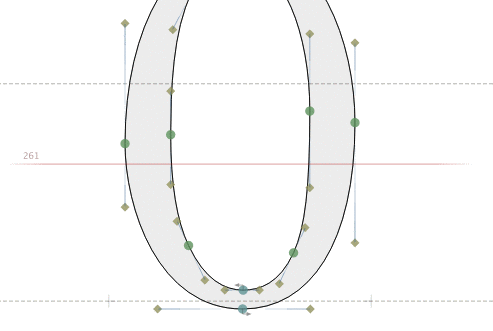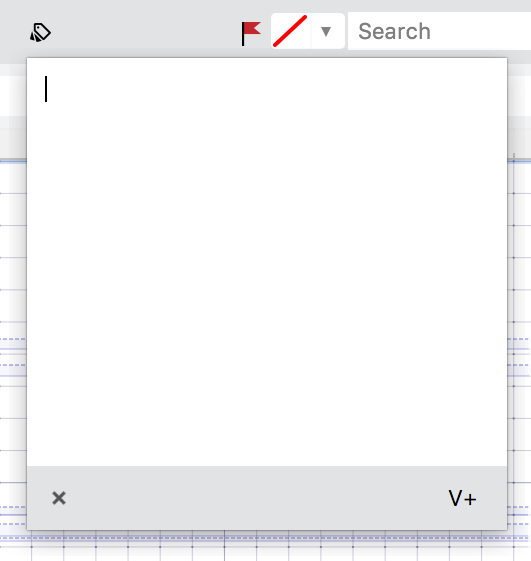Using Guides»
Guides are straight lines that are used to guide the drawing of specific elements of a glyph. Guides can be vertical, horizontal or slanted in orientation. They can be specific to a single element (an Element Guide), specific to a single glyph (a Glyph/Local Guide) or be applied to the entire font (a Font/Global Guide).
While Element and Glyph Guides can be used to help in drawing that particular element or glyph, Font Guides can be used to mark important levels in the font or to set the base direction of an italic or oblique font.
If you have a non-zero italic angle specified in Font Info > Font Dimensions, you can slant any guide to that angle with the guide’s context menu entry Slant to italic angle
Creating a guide»
Before you create guides, be sure that they are visible. Use the View > Glyph Guides and View > Font Guides commands to switch them on.
To add a new glyph or font guide:
- Position the mouse cursor on the horizontal ruler for a horizontal guide, or on the vertical ruler for a vertical guide.
- Click the ruler and while holding down the button, drag away from it to create the guide. Release the button when the guide is in the desired place.
If you release the button inside the glyph canvas (the lighter active area in the glyph window), a glyph guide will be created. Otherwise, a font guide will be created. You can reverse this behavior by pressing the Shift key.
To create a new guide from nodes: when you have two nodes selected, choose Tools > Add Guide to add a glyph guide that goes through those nodes.
To add a new element guide to the current element, use the Guides tool with the Alt key.
Changing the guide type»
To change the type of guide, Ctrl-click the guide and select Vector, Horizontal, Vertical, and/or Short.
- Vector adds a vector to the guide. Moving vector’s start and end points allows to slant guides or measure distances;
- Horizontal makes the guide horizontal;
- Vertical makes the guide vertical;
- Short shortens the glyph guide allowing to use it locally for a stem or some other glyph part.
To slant a guide:
- First make it a vector by Ctrl-clicking the guide, and selecting Vector in the context popup menu.
- Click the guide to select it. You will now see the arrow on the guide.
- Move one of the edges of this arrow or change the guide angle.
Selecting a guide»
To select a guide, just click it. Use Shift-click to select additional guides without losing your previous selections.
If one guide is already selected, use Edit > Select All to select all guides of that type (font guides or glyph guides).
Moving a guide»
To move a guide:
- Move the mouse cursor onto the guide that you want to move. Be sure that no other objects (such as nodes or hints) are near the cursor.
- Press the mouse button and drag the guide to a new place.
While you are dragging the guide, if the mouse cursor comes within the snap-to distance of a node, the guide will stick to the node. When this happens, nodes will become visible temporarily.
Duplicating a guide»
To duplicate an existing guide, drag it with the Alt key pressed.
Removing a guide»
To remove a guide, click the guide to select it, and press Del or BkSp.
Locking a guide»
You can lock any guide that you want to move only occasionally or don’t want to move at all. To do so, select Lock in the context popup menu, or click the Lock button in the Guide panel or the Property bar.
Notice that while you are editing a guide, its parameters are shown and can be changed in the Guide panel or the Property bar:

You can name guides here, as well as change their type, color, position, angle and thickness.
Note
You can copy both outlines and guides. If an outline is linked to a guide (see the Power Guides section), it will also be copied.
Guide Width»
Guides can now have width or thickness. To define the width for a guide, press Shift and drag the guide. You will notice the dotted line defining the width. You can change the width by dragging this line without Shift:

Guide Markers»
Guide markers appear on a guide where it crosses an outline. To see the markers, double-click the guide. If you now drag the guide, along with the markers, it will measure and show the thickness of the glyph strokes where it intersects with them:

If you double-click this guide a second time, that will lock the guide markers:

You can change position of markers manually in this mode. Positions of the locked markers are also visible and can be edited in the Guide panel.
To switch back to a normal guide without markers, double-click it once again.
Proportional Guide Markers»
By default, guide markers on a vector guide are proportional. That means if you change the length of a vector guide, the guide markers on it will move proportionally, and will acquire new proportional positions and thickness enclosed between them.
Example: The image below shows the vector guide with locked markers. The starting point of the vector is linked to the left point of the horizontal stem, the end point of the vector (with arrow) is linked to the right point. The guide markers show the thickness of the vertical stem:

Now if you start to change the length of the stem by moving its left or right point the markers will move proportionally showing you the new proportional thickness and position of the vertical stem:

To not let the guide markers change their positions, Ctrl-click the guide and turn off Proportional Marks in the context menu.
Guide Tags»
Guide tags are a way to make a font guide only show up on specific glyphs. If you use a tag on a guide, the guide only appears in those glyphs which have the same tag assigned to them. For example, if you assign the lc tag (one of FontLab’s built-in tags) to a guide, it will be visible only in lowercase glyphs.
To add a guide tag, select a font guide, click the Tag button in the Property bar and enter your text for the tag:

Guides Context Menu»
More commands related to a guide are available in a its context popup menu. The content of the context popup menu depends on the guide type. For example, a glyph guide’s popup menu contains the Copy to Font command, while a font guide’s popup menu will contain the Copy to Glyph command.
Copy to Glyph command will create a new glyph guide on top of the element one or the font one.
Copy to Font command will create a new font guide on top of the glyph one.
Create Orthogonal CW and CCW commands create a guide that is orthogonal to the current one.
Proportional Marks trigger to allow/not allow guide markers to change their positions when the length of a vector guide changes.
The commands in the Colors submenu allow you to change colors of individual guides.
The Snap trigger allows you to turn off snapping for that individual guide. If it is turned off for a guide, nodes will not snap to the guide regardless of the state of View > Snap > Font Guides and View > Snap > Guides commands.
And finally, you can Lock any guide, in case you wish to move it only occasionally or not change it at all.
Converting Guides into Alignment Zones or Hints»
You can convert guides into alignment zones or PostScript hints.
-
Create a guide (font or glyph)
-
Hold Shift and define the width for the guide to create the overshoot/thickness
-
Ctrl-click the guide and choose Zone to convert the guide to alignment zone or Hint to make a hint.
Use View > Show > Zones and View > Show > Hints to make hints and alignment zones visible if they are not.